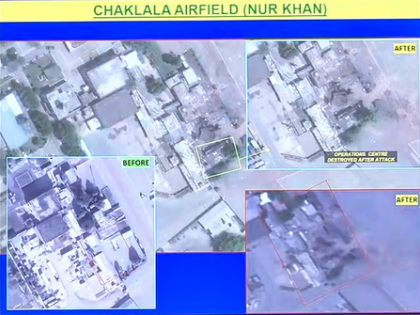Op-Sindoor: Satellite images reveal widespread damage at Pakistan's Nur Khan airbase than earlier presumed
By IANS | Updated: May 25, 2025 23:07 IST2025-05-25T23:00:23+5:302025-05-25T23:07:57+5:30
New Delhi, May 25 Recent satellite imagery suggests that Pakistan’s strategically important Nur Khan airbase sustained more extensive ...

Op-Sindoor: Satellite images reveal widespread damage at Pakistan's Nur Khan airbase than earlier presumed
New Delhi, May 25 Recent satellite imagery suggests that Pakistan’s strategically important Nur Khan airbase sustained more extensive damage during India’s ‘Operation Sindoor’ than previously believed.
Nur Khan, a vital hub for Pakistan’s drone and VIP air fleet, is located in Rawalpindi, less than 25 kilometres from Islamabad. The base is a high-value target, housing key assets of the Pakistan Air Force.
“A review of Nur Khan Airbase, Pakistan, reveals the entire complex near India’s strike location has now been demolished, suggesting the strike’s effect went beyond the two special-purpose trucks—possibly presenting a broader footprint of the damage,” defence analyst Damien Symon posted on X.
A fresh assessment reveals that a large complex near the strike site has been demolished, expanding the perceived impact of the Indian Air Force’s precision strikes.
According to The Intel Lab, which shared the latest satellite visuals, the destruction appears to go beyond the previously reported damage to two special-purpose trucks. Earlier reports based on satellite analysis indicated that India carried out precision strikes between May 8 and 10, targeting infrastructure and ground support systems at the Rawalpindi-based airbase. The attack was viewed as both strategic and symbolic, as the base lies close to the Pakistan Army’s headquarters and serves as the command centre for air mobility operations. These operations include Saab Erieye airborne early warning systems, C-130 transport aircraft, and IL-78 mid-air refuelling planes, which are critical for logistics, surveillance, and operational coordination.
The base also houses Turkish-made Bayraktar TB2 drones and Pakistan’s indigenous Shahpar-I drones, used for targeting and surveillance missions.
Nur Khan is central to Pakistan’s drone warfare strategy and hosts the country’s elite pilot training and VIP fleet, including the presidential aircraft. The scale of the strike has exposed significant vulnerabilities in Pakistan’s air defence system.
Adding to the narrative, Pakistan Prime Minister Shehbaz Sharif recently revealed that he was awakened in the early hours of May 11 by army chief General Syed Asim Munir, who informed him that Indian ballistic missiles had hit multiple airbases, including Nur Khan.
Recently, Sharif said during a public meeting that he had received a call from General Munir at 2:30 a.m. on a secure line. He told him that India had just launched ballistic missiles, and one of them fell at Nur Khan Airport. He was speaking on Youm-e-Tashakur (Day of Thanks).
According to Sharif, Pakistan retaliated by striking Indian locations, including Pathankot and Udhampur. The escalation followed the April 22 terror attack in Pahalgam, Jammu and Kashmir, in which 26 people killed.
India launched Operation Sindoor on May 7, targeting terror infrastructure in Pakistan. In response, Pakistan attempted missile attacks on May 8, 9, and 10.
Disclaimer: This post has been auto-published from an agency feed without any modifications to the text and has not been reviewed by an editor
Open in app